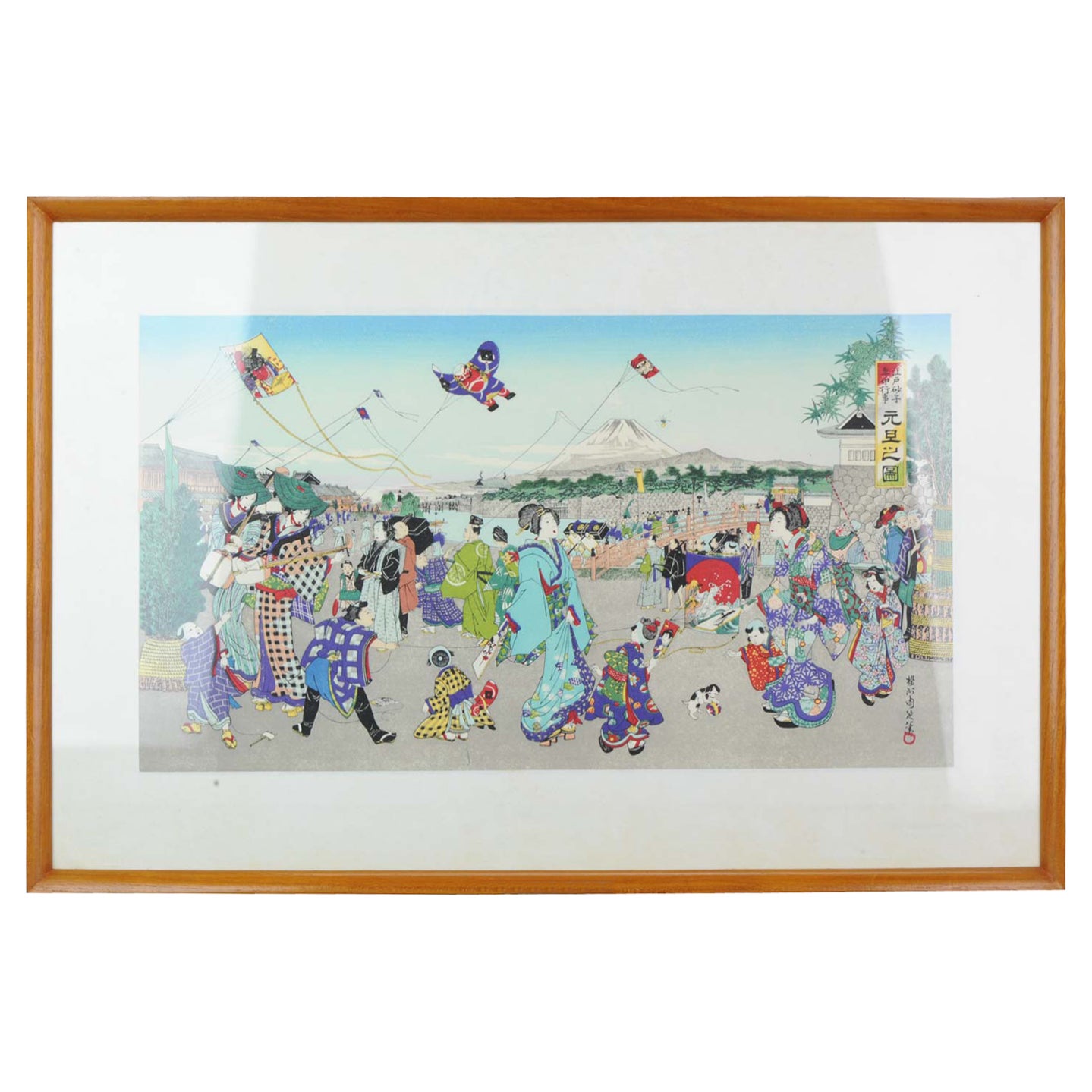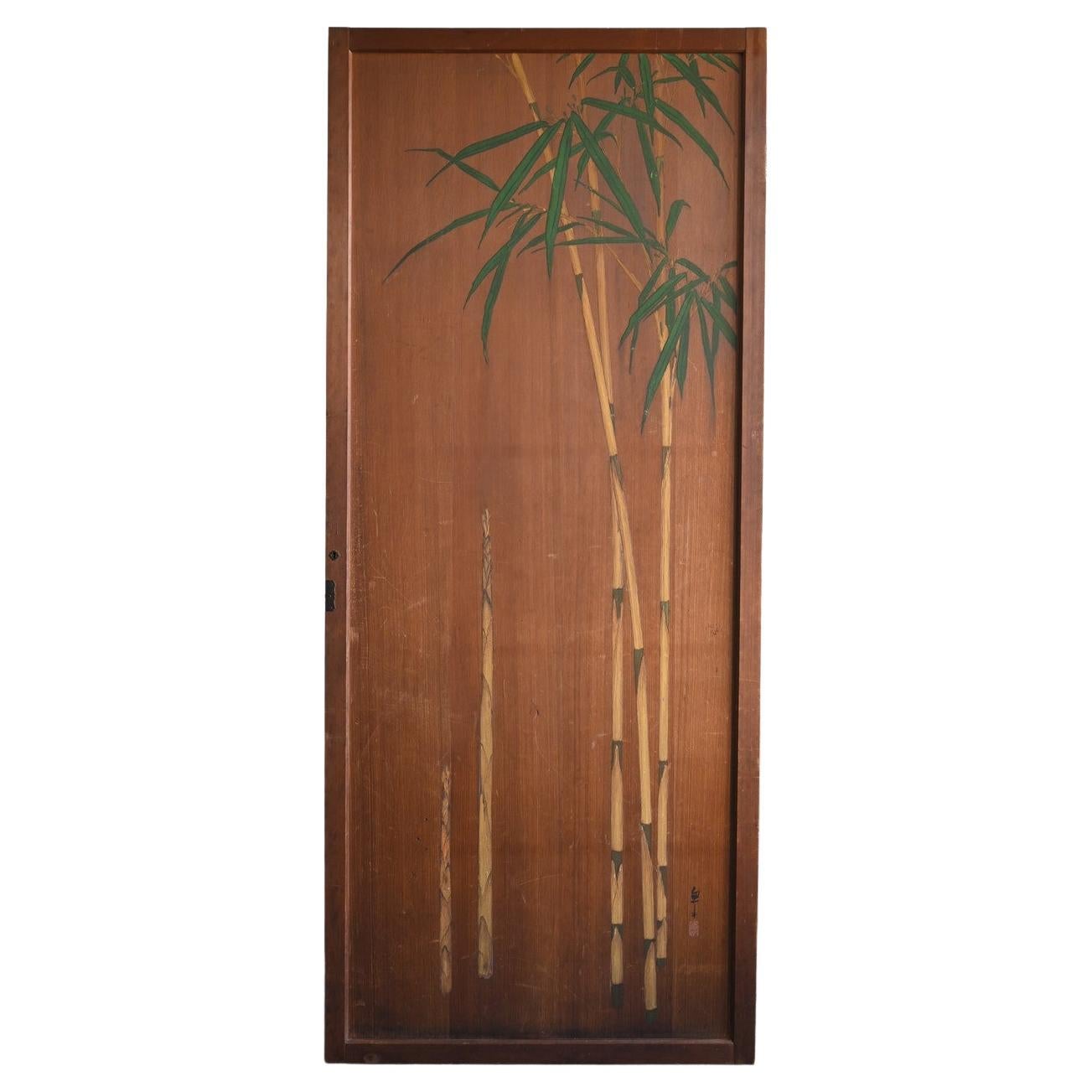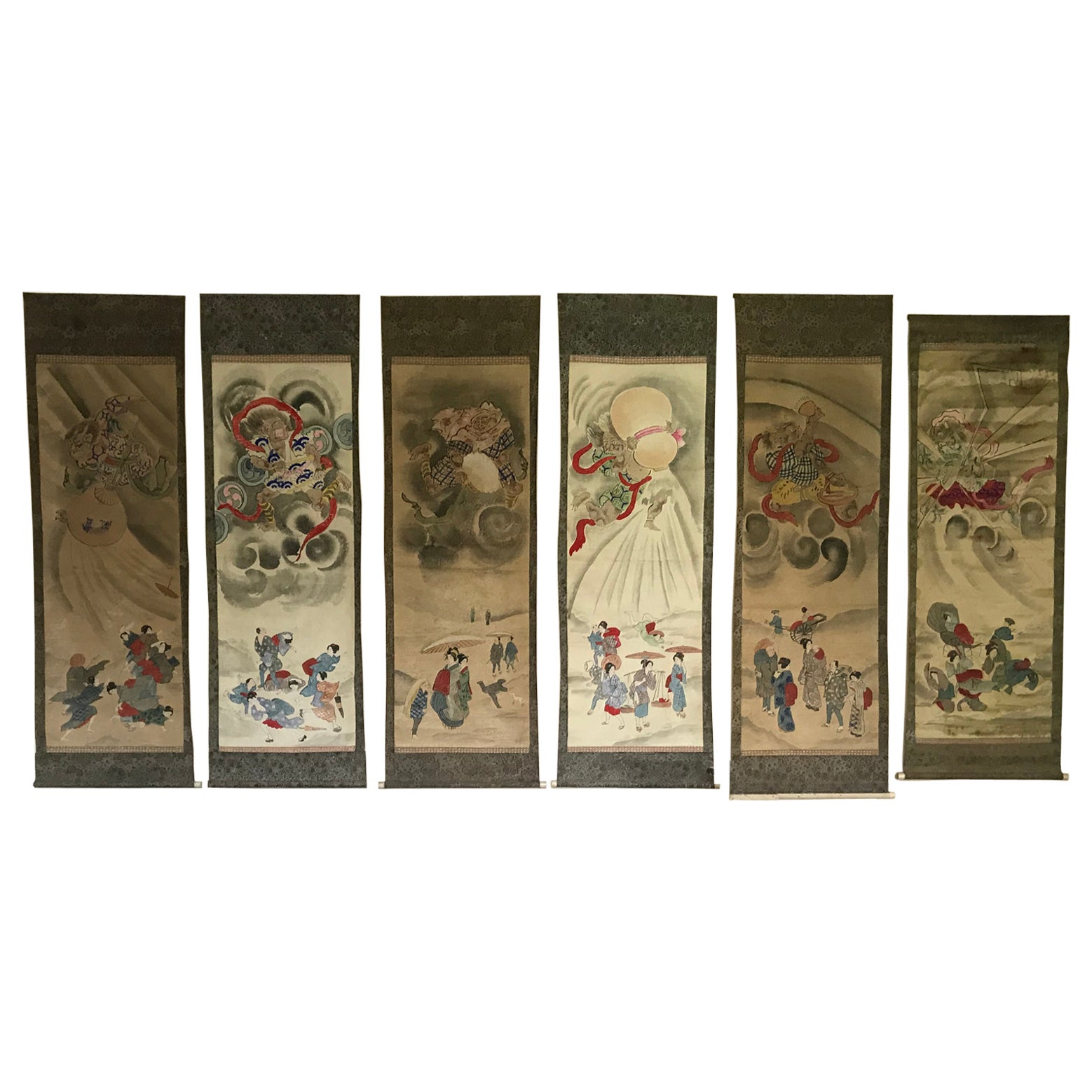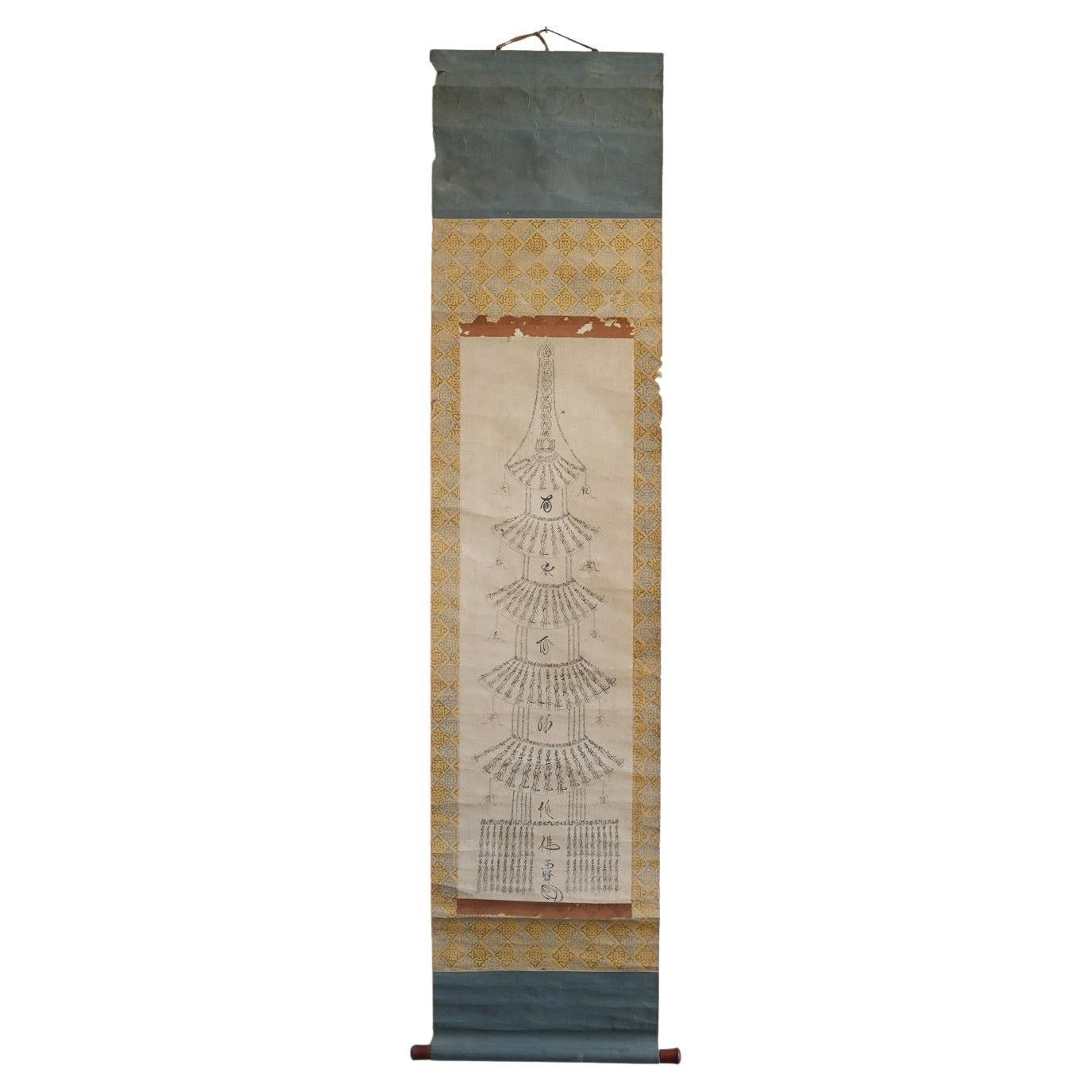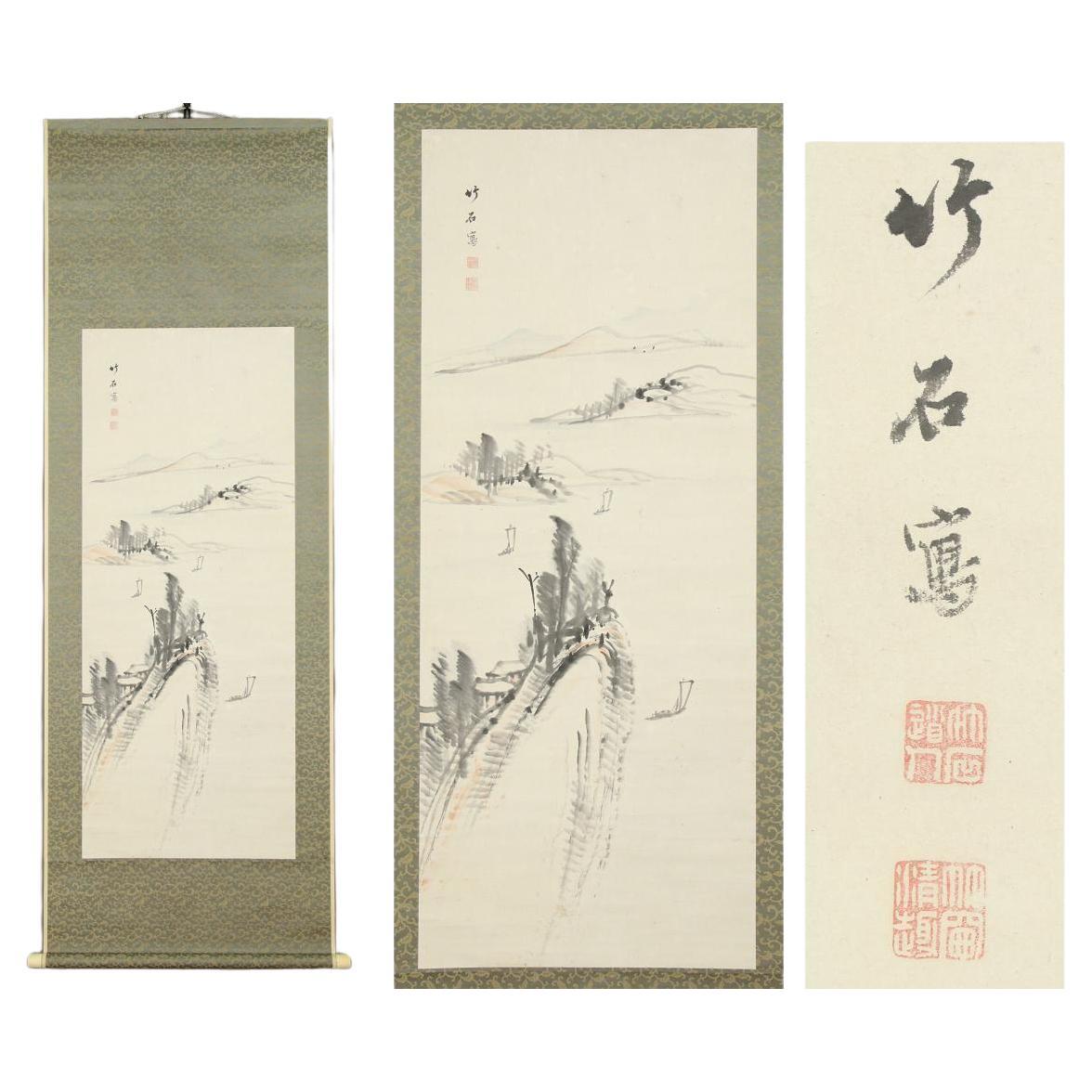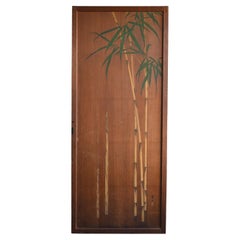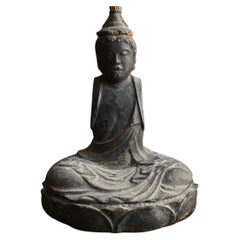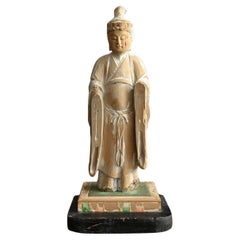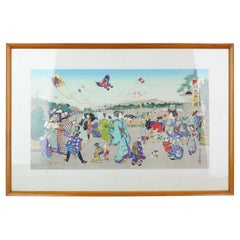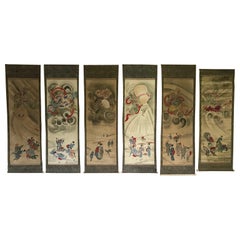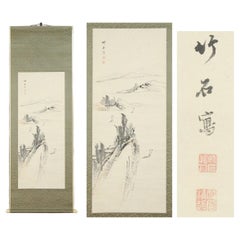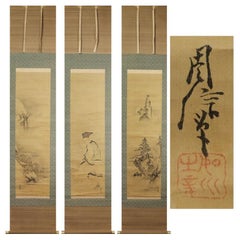Items Similar to A rare wooden sliding door with Japanese paintings/1800-1920/Edo-Meiji
Want more images or videos?
Request additional images or videos from the seller
1 of 21
A rare wooden sliding door with Japanese paintings/1800-1920/Edo-Meiji
About the Item
This is a wooden sliding door produced in Japan from the late Edo period to the Meiji period. This piece, which must have watched over people's lives for many years, is more than just a piece of fixture; it is a work of art worthy of appreciation as a painting.
It is thought to have originally been used inside temples and wealthy houses, and is characterized by the different designs on the front and back sides. It is a very atmospheric design that allows the surface to be changed according to the space, season, or mood.
On the surface, a group of white chrysanthemums in full bloom and butterflies dancing around them are delicately depicted. Since ancient times, white chrysanthemums have been considered a noble flower and believed to have the power to ward off evil spirits. In Japanese culture, chrysanthemums symbolize the wish for family happiness, and butterflies signify change, growth, and eternal life. The composition of these two nestled together is truly an auspicious design wishing for happiness and long life. The background is decorated in gold, enveloping the dancing butterflies with soft light and creating a fantastic atmosphere. The petals are painted in gofun (Chinese lacquer powder), and each petal has a three-dimensional effect, showing the careful craftsmanship of the artist.
The reverse side depicts an egret with wings spread wide, quietly descending. The wide margins and the composition of the image emphasize the grace and movement of the egret even more. In the lower part of the painting, flowers and grasses, perhaps lotus, are discreetly arranged, giving the painting a very serene and dignified atmosphere. The egret is a bird that represents “purity” and “good omen” in Japanese culture, and the lotus is a flower that symbolizes “purity of mind” and “rebirth” in Buddhist terms.
Now that it has completed its role as a sliding door, this work is now a painting that beautifully directs the space. It looks great not only in a Japanese-style room, but also in a modern space or gallery-style interior. It can be hung on the wall by attaching metal fittings to the wall.
Although there are some age-related defects such as peeling of the gofun, minor rubbing, and dents, it is this texture that gives the work its depth. The lower left side of the egret depicted on the frame is partially chipped.
The white chrysanthemum part is particularly delicate and easily peeled off, so please handle with care.
Please note that due to the delicate nature of the gofun (white shell powder pigment) used in the painting—especially in the chrysanthemum area—there is a slight risk that some of it may flake off during international shipping due to vibration or impact. While we will take every precaution to pack the item as carefully and securely as possible to minimize any chance of damage, we kindly ask for your understanding should minor flaking occur in transit. We deeply appreciate your understanding and support, and we promise to do our utmost to ensure the piece arrives safely and beautifully.
A gem of culture, aesthetics, and the memory of a long time condensed into a single piece. We hope you will welcome it as an art piece that speaks of a new value of beauty beyond the role of fittings in the modern age.
In general, there are very few items with delicate paintings on wooden sliding doors like this, making them very rare items. There are no two items that are the same, making this a one-of-a-kind piece. Please take advantage of this opportunity.
Size: w91.3-91.5 cm d3.2 cm h171.4-172 cm
Weight: 8.8 kg
- Dimensions:Height: 67.72 in (172 cm)Width: 36.03 in (91.5 cm)Depth: 1.26 in (3.2 cm)
- Style:Edo (Of the Period)
- Materials and Techniques:
- Place of Origin:
- Period:
- Date of Manufacture:1800-1920
- Condition:Due to the delicate nature of the gofun pigment, especially on the white chrysanthemums, there is a small risk of minor flaking during shipping. We will pack the item with the utmost care to prevent this, but we kindly ask for your understanding in c.
- Seller Location:Sammu-shi, JP
- Reference Number:1stDibs: LU5487244647432
About the Seller
5.0
Platinum Seller
Premium sellers with a 4.7+ rating and 24-hour response times
Established in 2015
1stDibs seller since 2020
1,575 sales on 1stDibs
Typical response time: 4 hours
- ShippingRetrieving quote...Shipping from: senzoku, Japan
- Return Policy
Authenticity Guarantee
In the unlikely event there’s an issue with an item’s authenticity, contact us within 1 year for a full refund. DetailsMoney-Back Guarantee
If your item is not as described, is damaged in transit, or does not arrive, contact us within 7 days for a full refund. Details24-Hour Cancellation
You have a 24-hour grace period in which to reconsider your purchase, with no questions asked.Vetted Professional Sellers
Our world-class sellers must adhere to strict standards for service and quality, maintaining the integrity of our listings.Price-Match Guarantee
If you find that a seller listed the same item for a lower price elsewhere, we’ll match it.Trusted Global Delivery
Our best-in-class carrier network provides specialized shipping options worldwide, including custom delivery.More From This Seller
View AllWooden door with old Japanese bamboo painting/Wall hanging painting/Wooden door
Located in Sammu-shi, Chiba
This is a one-panel wooden door made in Japan around the 20th century. The material used is presumed to be Japanese cypress or Japanese cedar, and the delicately straight grain of th...
Category
20th Century Japanese Taisho Paintings
Materials
Cedar
Antique Japanese Buddhist pagoda hanging scroll /Buddhist painting/Edo
Located in Sammu-shi, Chiba
This is a slightly different Buddhist painting believed to have been created by a Japanese temple monk during the Edo period (late 17th to 19th century). Rendered in ink on paper, th...
Category
Antique 18th Century Japanese Edo Paintings
Materials
Paper
Japanese antique wooden Buddha statue / Edo period / 1600 to 1800
Located in Sammu-shi, Chiba
This wooden statue is a relic from Japan's Edo period, and within it lies a deep history that transcends time. Originally, it was part of a more intricate statue, likely adorned with...
Category
Antique 17th Century Japanese Edo Sculptures and Carvings
Materials
Cypress
Wooden Buddha statues from the Edo period in Japan/1800-1868/Late Edo period
Located in Sammu-shi, Chiba
This wooden Buddhist statue was made in the late to late Edo period.
It is thought to be a statue of Kannon Bodhisattva.
It was originally placed in a shrine and was painted, but the...
Category
Antique 19th Century Japanese Edo Sculptures and Carvings
Materials
Cypress
Japanese antique wooden blocks/1800-1920/paper charms/Buddhist art
Located in Sammu-shi, Chiba
This is a wooden woodblock produced in Japan from the late Edo period to the Taisho period (about 1800s to 1920s). The material used is something like beech wood, and the wood is dec...
Category
Antique Late 19th Century Japanese Edo Wall-mounted Sculptures
Materials
Beech
Antique Wooden Sculpture "Kobo Daishi" / Buddha Statues / Edo-Meiji Period
Located in Sammu-shi, Chiba
This is an old Japanese "Kobo Daishi" wooden figure.
"Kobo Daishi" means "Kukai".
"Kukai" was a monk from the early Heian period. His posthumous name was "Kobo Daishi". He is the fou...
Category
Antique 19th Century Japanese Edo Sculptures and Carvings
Materials
Cypress
You May Also Like
Antique Japanese Blockprint Painting Japan Edo or Meiji
Located in Amsterdam, Noord Holland
Antique Japanese Blockprint Painting Japan Edo or Meiji.
A very nice blockprint.
Additional information:
Type: Paintings, Scrolls & Prints
Region of Origin: Japan
Country of Manufa...
Category
Antique 19th Century Japanese Paintings
Set of 6 Large Kakemonos Japanese Mythology, 19th Century Japan circa 1800 Edo
Located in Beuzevillette, FR
Beautiful set of 6 large kakemonos from 19th century Japanese mythology.
Paper support with a canvas pasted on the paper
Wonderful set that is part of Japan's history and beliefs
When not hung, the Kakemonos are rolled up.
circa 1800 - Japan - Edo Period
A kakemono translates as "object to hang". In Japan this refers to a painting or calligraphy, most often done on silk or paper framed in a scroll that was intended to be hung on walls or in public lighting. This particular form, which allows them to be in a roll, dates back to the Tang dynasty in China (this would be related to the copying and preservation of ancient Buddhist texts). A Kami is a deity or spirit worshipped in the Shinto religion. A Yokai is a spirit, ghost, demon, or strange apparition from the creatures of Japanese folklore.
Each of these kakemonos represents a unique story:
- A kami, a Japanese deity, is shown painting a rainbow. Indeed, he performs the action with his right hand while his left hand holds a kind of basket with three pots of paint. This kami has a rather closed attitude. He is standing in a dark and tormented sky. Below this figure, 8 villagers are dressed in traditional Japanese clothes. Their faces are softened. They are not afraid of the elements made by the kami above their heads.
- A character with an unreal look is holding a kind of jar with his two hands, which he spills on human figures above. This being is floating in the air, probably a character from mythology, perhaps Susanoo. Underneath, villagers on umbrellas. They are trying to protect themselves as best they can from what is falling on them. One of them is carrying baskets with fish on her shoulders. A character in the background is thrown forward and falls.
- On this kakemono, the god Raijin, dressed in a white and blue outfit, strikes the sky with his two drum hammers to create lightning and its thunderous sound. Surrounded by Tomoe and a long red scarf, Raijin, enraged and with dishevelled hair, creates a dark and violent storm. The villagers seem frightened by this meteorological phenomenon. One of the villagers can be seen fainting in the arms of a man. This scene may seem chaotic, but Japanese legend tells us that once a field is struck by lightning, the harvest is good.
- On this kakemono, we see an unreal-looking figure holding a fan, as if he were sweeping away the bad weather, or simply producing gusts of wind. He is probably the kami of wind and air, Shina tsu-hiko. The figures below him seem surprised by so much wind. An umbrella flies away on the left, the women hold their hair and scarf, the clothes are caught in the power of the wind, there is even a woman on the ground on the bottom left.
- This Kakemono represents a short moment. This Raiju is a yokai (ghost spirit...
Category
Antique 19th Century Japanese Edo Paintings
Materials
Paper
Japanese Painting 18c Edo Scroll Chikuseki Nagamachi Nihonga Landscape Painting
Located in Amsterdam, Noord Holland
[Authentic Artwork] ◆ Nagamachi Chikuseki ◆ Landscape ◆ Edo Period ◆ Mitsuishi Origin ◆ Kagawa Prefecture ◆ Handwritten ◆ Paperback ◆ Hanging Scroll ◆ k891 ◆ Nagamachi Chikuseki
Explore the artistry of Chikuseki Nagamachi...
Category
Antique 18th Century Edo Paintings
Materials
Silk
$1,788 Sale Price
20% Off
Japanese Painting 17th c Edo Scroll Triptyque Kano Chikanobu Buddhist Painting
Located in Amsterdam, Noord Holland
TheItem below was painted approximately 300 years ago by Kano Chikanobu. In the center is a depiction of a deer hermit, on the right is a landscape of a tower that gives a sense of ...
Category
Antique 17th Century Edo Paintings
Materials
Silk
$3,387 Sale Price
20% Off
Antique Japanese 17th c Edo Scroll Kano Yosanobu Buddhist Painting
Located in Amsterdam, Noord Holland
Eishin Kano's Ebisu/Great Country Map, double-width/comes with an old box.
The auspicious statues of Ebisu and Daikoku are standing in a double-width hanging scroll with a smiling fa...
Category
Antique 18th Century Edo Paintings
Materials
Silk
$3,390 Sale Price
20% Off
Japanese Edo Period Festival Screen, c. 1750
Located in Chicago, IL
This 18th century folding screen is a stunning example of Japanese artistry. Beautifully painted with delicate brushwork, the evocative sc...
Category
Antique Mid-18th Century Japanese Edo Paintings and Screens
Materials
Paper
